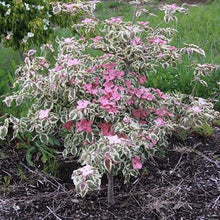A Colorful Twist on the Traditional Dogwood
This new Dogwood variety puts on colorful shows all year that takes the breath of spectators, because they've probably never seen a dogwood with these unique color combinations before.
Each spring green leaves emerge with creamy, white, variegated edges. As the season continues into summer the leaves start getting blotches of pink that slowly spreads, until fall when they fully turn a shade of rosy lavender. The leaves change colors so often that your neighbors won't be able to keep up with how often your landscape shows of new bright, popping colors.
Not only do the leaves change shades, but so do the flowers! Each flower starts off as a pure white bloom, and as the summer heat sets in they turn into bright shades of pink. It's like you get two different floral shows in a single tree.
In the winter when other trees are lifeless, the Akatsuki Dogwood sports bright red berries that pop against the snow. The berries not only possess beauty, they also attract a variety of birds, giving spectators a lovely show in their own yards.
The compact nature of this tree allows it to be grown in any gardening space, because Akatsuki Dogwoods only grow about 8 - 10 feet tall. Their small size combined with the fact that they naturally grow in a vase shape makes them the perfect specimen tree.
Because these trees are in the dogwood family, they have all the easy growing benefits that other dogwood varieties do. They will adapt to a variety of poor soils, they're drought tolerant, and extremely low maintenance. Once planted, these tough trees will be giving you colorful shows for decades.
This unique colorful tree sells out fast. Be sure to order yours today, before they're gone.
Planting & Care
The Akatsuki Dogwood (Cornus Kousa ‘Akatsuki”) is recommended for USDA growing zones 5-8 and is a small, deciduous tree that reaches a mature height and width of only 8-10 feet. It’s a perfect addition to any small garden that needs color all year long. In spring, the leaves are a combination of bright green and white with variegated edges. As the seasons progress, the leaves gradually turn into amazing shades of pink, rose, lavender and mauve. As the leaves change through the seasons, so do the flowers. They start of white and turn into shades of rosy-pink. Finally in winter when all other trees are lifeless, your Akatsuki Dogwood produces bright red berries which attract different varieties of birds.
Location: Choose a planting site for your Dogwood that receives light or filtered shade. Dogwood trees are highly adaptable to many soil types. However, they thrive best in moist, fertile soils high in organic matter. The soil of your planting site should be well draining, with a 5.5 pH level.
Planting Instructions:
1) Dig a planting hole for your dogwood that is three times the diameter of your tree’s root ball and comprised of equal depth.
2) Remove your Dogwood from its container and ensure root moisture.
3) Place your tree in the planting hole, keeping the top of the root ball even with the ground.
4) Adjust your tree’s position and angle, then use the original soil to fill the planting hole.
5) Spread the roots out evenly and surround them with soil, tamping down lightly as you fill to avoid air pockets, which can dry out the roots of your tree.
6) Avoid firming the soil at this point, and instead water the area immediately to settle the soil.
7) Mulch around the base of the tree to conserve soil moisture. This will also keep competing growth (grass and weeds) from growing around the planting site.
Watering: Dogwood trees possess very shallow root systems that are susceptible to drying out in the absence of regular rainfall. It is best to water your tree once or twice a week. Be sure to water correctly. Light green leaves are a sign of over watering, while drooping leaves signify both over watering and under watering. Watch for these and any other signs that your tree is getting too much or too little water.
Fertilization: Dogwood trees do not require much fertilization. If you choose to fertilize your tree, do so sparingly in April or May. Any general purpose fertilizer is suitable for this.
Weed Control: Do not permit weeds or grasses any closer than 2-3 feet from your Dogwood in the first year. Pull the weeds initially, and then utilize a growing mat or mulch. Insulate the roots 2-4 inches and replenish as needed. Do not spray RoundUp on a young Dogwood, and ensure that wind does not blow chemical drift onto your tree.
Pests & Disease: The best defense against any pest or disease issue is a healthy tree. Good soil, proper feeding & healthy watering habits are vital to the prosperity of your tree.
Deer: If you believe that deer may become an issue for your Dogwood, consider caging the tree(s). Although there is a whole host of deer deterrents available, nothing will guarantee protection like caging will.
Winter Dormancy: During late fall and winter, your Dogwood will enter its dormant state. When this occurs, your tree’s leaves will fall off and the stem will turn brown. Above ground, nothing will take place during this time, but the roots of your tree will continue to grow beneath the surface. This winter root development will accelerate the growth of your tree come spring.







